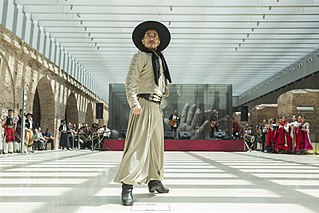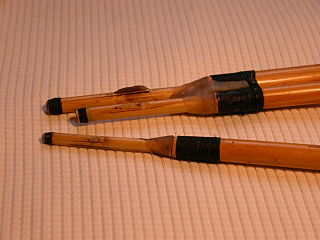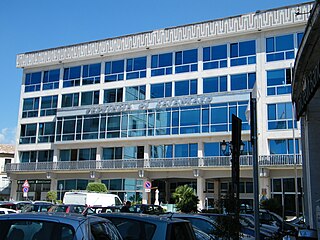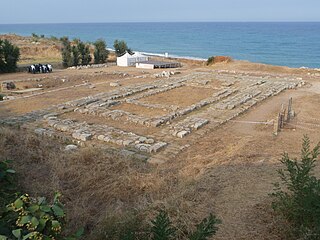
A folk dance is a dance developed by people that reflect the life of the people of a certain country or region. Not all ethnic dances are folk dances. For example, ritual dances or dances of ritual origin are not considered to be folk dances. Ritual dances are usually called "Religious dances" because of their purpose. The terms "ethnic" and "traditional" are used when it is required to emphasize the cultural roots of the dance. In this sense, nearly all folk dances are ethnic ones. If some dances, such as polka, cross ethnic boundaries and even cross the boundary between "folk" and "ballroom dance", ethnic differences are often considerable enough to mention.

Calabria, is a region in Southern Italy. It is bordered by Basilicata to the north, the Gulf of Taranto to the east, the Ionian Sea to the south, the Strait of Messina to the southwest, which separates it from Sicily, and the Tyrrhenian Sea to the west. With almost 2 million residents across a total area of approximately 15,222 square kilometres (5,877 sq mi), it is the tenth populous and the tenth-largest Italian region by area. Catanzaro is the region's capital, while Reggio Calabria is the most populous city in the region. Calabria is the 14th most productive region in the country. The Pollino National Park with 192,565 ha is the largest national park in the country and ranks among the 50 largest in the world.
Tarantella is a group of various folk dances characterized by a fast upbeat tempo, usually in 6
8 time, accompanied by tambourines. It is among the most recognized forms of traditional southern Italian music. The specific dance-name varies with every region, for instance tammurriata in Campania, pizzica in the Salento region, and Sonu a ballu in Calabria. Tarantella is popular in Southern Italy and Argentina. The term may appear as tarantello in a linguistically masculine construction.

Zampogna is a generic term for a number of Italian double chantered pipes that can be found as far north as the southern part of the Marche, throughout areas in Abruzzo, Latium, Molise, Basilicata, Campania, Calabria, and Sicily. The tradition is now mostly associated with Christmas, and the most famous Italian carol, "Tu scendi dalle stelle" is derived from traditional zampogna music. However, there is an ongoing resurgence of the instrument in secular use seen with the increasing number of folk music festivals and folk music ensembles.
Themusic of Italy has traditionally been one of the cultural markers of Italian national and ethnic identity and holds an important position in society and in politics. Italian music innovation – in musical scale, harmony, notation, and theatre – enabled the development of opera, in the late 16th century, and much of modern European classical music – such as the symphony and concerto – ranges across a broad spectrum of opera and instrumental classical music and popular music drawn from both native and imported sources.

The launeddas are a typical Sardinian woodwind instrument made of three pipes. They are a polyphonic instrument, with one of the pipes functioning as a drone and the other two playing the melody in thirds and sixths.

The province of Catanzaro is a province of the Calabria region of Italy. The city Catanzaro is both capital of the province and capital of the region of Calabria. The province contains a total of 80 municipalities (comuni). Its provincial president is Sergio Abramo.
Sardinia is probably the most culturally distinct of all the regions in Italy and, musically, is best known for the tenore polyphonic singing, sacred chants called gosos, the launeddas, an ancient instrument that consists of a set of three single-reed pipes, all three mouth-blown simultaneously using circular breathing, with two chanters and one drone and the cantu a chiterra, a monodic song that is accompanied by guitar, widespread mainly in the center and north of the island.
Italian folk music has a deep and complex history. National unification came quite late to the Italian peninsula, so its many hundreds of separate cultures remained un-homogenized until quite recently compared to many other European countries. Moreover, Italian folk music reflects Italy's geographic position at the south of Europe and in the center of the Mediterranean Sea: Celtic, Slavic, Arabic, Greek, Spanish and Byzantine influences are readily apparent in the musical styles of the Italian regions. Italy's rough geography and the historic dominance of small city states has allowed quite diverse musical styles to coexist in close proximity.
The music of Calabria is part of the Italian musical tradition. Like other regions in southern Italy, Calabria for many centuries was an integral part of the kingdom of Naples, and, as with other regions, the musical life tended to be overshadowed by the important activities in the capital city to the north—the conservatories there, the composers, the vast amount of music performed in churches. Yet, modern Calabria has developed a vibrant musical life based on its history and, as well, a dedication to building new musical and theatrical facilities, many of which are of the type termed polivalenti in Italian—that is, multi-purpose.
This is an article on the terminology used to describe the music of Italy. There is also an article on Italian musical terms used in English.

Diamante is a coastal town and comune in the province of Cosenza, part of the Calabria region of southern Italy.
The Sanctuary of Our Lady of Polsi, also known as the Sanctuary of Santa Maria di Polsi or Our Lady of the Mountain, is a Christian sanctuary in the heart of the Aspromonte mountains, near San Luca in Calabria, southern Italy. It was founded by Roger II of Sicily in 1144. The church and monastery are situated in a spectacular setting at the bottom of a gorge at an altitude of 865 metres surrounded by high mountains on the east side of the Montalto the highest peak of the Aspromonte. The sanctuary is difficult to reach. Until some years ago Polsi could only reached by foot.

The Calabrian lira is a traditional musical instrument characteristic of some areas of Calabria, region in southern Italy.

Italian folk dance has been an integral part of Italian culture for centuries. Dance has been a continuous thread in Italian life from Dante through the Renaissance, the advent of the tarantella in Southern Italy, and the modern revivals of folk music and dance.

The ciaramedda or ciaramèddha (Sicilian) is a type of zampogna with equal length double chanters. Other terms for this instrument include "zampogna a paru" and "terzalora" or simply "cornamuse".
The Italo-Dalmatian languages, or Central Romance languages, are a group of Romance languages spoken in Italy, Corsica (France), and formerly in Dalmatia (Croatia).

Antonio Nicaso is an Italian author, university professor, researcher, speaker and consultant to governments and law-enforcement agencies originally from Caulonia, Calabria, Italy, now based in Toronto, Ontario, Canada. He is an expert on the Calabrian mafia. Nicaso lives and works in North America. He teaches courses on "Social History of Organized Crime in Canada" and "Mafia Culture and the Power of Symbols, Rituals and Myth" at Queen's University, in Kingston, Ontario. He also teaches at St. Jerome's University in Waterloo, Ontario and the Italian School of Middlebury College in Oakland, California in the United States and is the co-director of the Research in Forensic Semiotics Unit at Victoria College.

Caulonia or Caulon was an ancient city of Magna Graecia on the shore of the Ionian Sea. At some point after the destruction of the city by Rome in 200 BC, the inhabitants moved to a location further inland. There they founded Stilida, which developed into the modern town Stilo.

Alessandra Belloni is an Italian musician, singer, dancer, actress, choreographer, teacher, and ethnomusicologist. Her instrument is the Southern Italian tambourine and her music and dance are focused on the traditional roots of tarantella. Her studies of tarantism are rooted in the culture of Apulia and Calabria, expressing it from women's point of view. Her work has gained international appreciation, especially in the United States and Brazil. She is artist in residence at the Cathedral of St. John the Divine.












